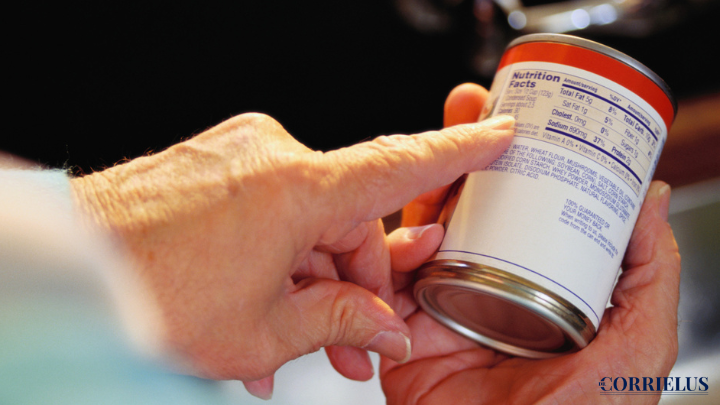Eating healthy is crucial for a strong and happy heart. When you shop for food, it’s important to understand what’s inside the products. You can do this by reading food labels carefully. Food labels give you a clear idea of what you’re putting into your body. In this blog, we will go over the basic steps to read nutrition labels for heart health and help you make healthier choices.
What’s Hiding Behind the Food Labels?
Every packaged food comes with a nutrition facts label. It tells you everything you need to know about the food’s nutritional value. It includes details about calories in food, fat content, vitamins, and minerals. The first step to a healthy diet plan is understanding these numbers.
Key Information on the Nutrition Facts Label
- Calories in Food: This tells you how much energy you get from eating the food. Eating too many calories can lead to weight gain, which may harm your heart. Keep track of the calories to avoid overeating.
- Total Fat: Fat is important, but too much can be unhealthy. Look for foods that have less unhealthy fats (like saturated fats and trans fats). Healthy fats, like those in nuts and seeds, are good for your heart.
- Sodium: High sodium levels can raise blood pressure, which is bad for your heart. Always check the sodium content on nutrition labels for food and try to keep it low.
- Cholesterol: High cholesterol can clog arteries and cause heart disease. Look for food that is low in cholesterol to support heart health.
- Fiber: Foods that are high in fiber can help keep your heart healthy. Fiber helps lower bad cholesterol levels and improve overall digestion.
Breaking Down the Nutrition Labels for Heart Health
Nutrition labels for food show you many different things, but some are more important for heart health. Here are some things to look for to support a healthy diet plan:
- Limit Unhealthy Fats
- Saturated fats and trans fats are not good for your heart.
- Healthy eating habits include eating foods with less of these fats.
- Look for healthy fats like those in olive oil, nuts, and avocado.
- Read food labels to make sure they’re low in these fats.
- Aim for foods with 0g trans fat and low saturated fat.
- Saturated fats and trans fats are not good for your heart.
- Watch Sodium Levels
- Too much salt can hurt your heart by raising blood pressure.
- Choose healthy diet foods that are low in sodium.
- Many processed foods have high sodium levels, so check the labels.
- Pick fresh fruits and vegetables that don’t need added salt.
- Low-sodium options are often available for most products.
- Too much salt can hurt your heart by raising blood pressure.
- Choose High-Fiber Foods
- Fiber is great for heart health. It helps reduce cholesterol levels.
- Healthy foods to eat every day should include fiber-rich options like fruits, vegetables, and whole grains.
- Check the food labels to find how much fiber a product has.
- Aim for at least 25-30 grams of fiber each day for better heart health.
- Fiber helps you feel full and supports digestion too.
- Fiber is great for heart health. It helps reduce cholesterol levels.
- Watch for Hidden Sugars
- Sugary foods may cause weight gain, which harms your heart.
- Check for added sugars on the nutrition facts label.
- Foods with high sugar content can cause inflammation and increase the risk of heart disease.
- Stick to foods with natural sweetness like fruits.
- Healthy eating includes minimizing sugar intake.
- Sugary foods may cause weight gain, which harms your heart.
- Look for Heart-Healthy Nutrients
- Choose foods with vitamins, minerals, and antioxidants that support heart health.
- Nutrients like potassium, magnesium, and vitamin C are good for your heart.
- Some healthy foods to eat every day are rich in these nutrients, such as leafy greens and berries.
- These nutrients can lower blood pressure and reduce inflammation.
- Always check for these beneficial nutrients on the food labels.
- Choose foods with vitamins, minerals, and antioxidants that support heart health.
Creating a Healthy Eating Plan for Heart Health
When you make a healthy eating plan, pay attention to food labels. The right food choices can help protect your heart and lower the risk of heart disease. Here’s how to create a healthy eating plan based on nutrition facts labels:
- Start by reading the labels on all the foods you buy.
- Aim to eat a variety of healthy foods to get all the essential nutrients.
- Focus on portion sizes to manage calories in food.
- Avoid foods with high levels of unhealthy fats, sodium, and sugars.
- Add plenty of whole foods like fruits, vegetables, and whole grains to your meals.
Healthy Eating Habits Lead to a Healthier Heart
The choices you make at the grocery store can have a big impact on your heart health. When you start to focus on reading nutrition labels for food and pick healthy options, you are building healthy eating habits. These habits will last a lifetime and support your heart in staying strong and healthy.
A word from the Doctor —
Reading food labels is an important step in taking care of your heart. The nutrition facts label helps you see what’s inside the food you eat. By paying attention to calories in food, fat content, fiber, and other nutrients, you can make better choices that support your heart health. Use food labels to guide you toward healthy diet foods, and soon, you’ll be on your way to a heart-healthy eating plan that works for you!
Schedule a consultation with Dr. Sanul Corrielus right away if you have questions about your heart health!



